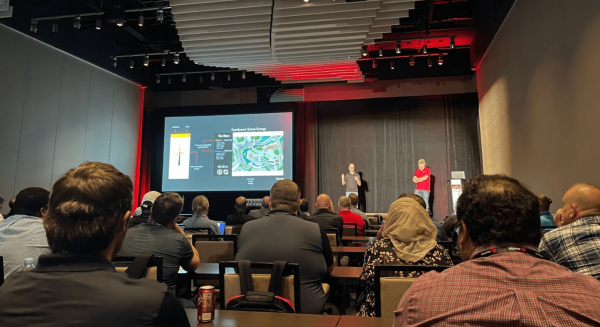Red Hat Summit: Connect brought updated topics and tech from Red Hat’s annual Summit closer to partners, customers and developers with a succession of events in New York, Dallas and San Francisco during the last two weeks of September. In each city, select audiences of around 200 joined Red Hat and partner experts for talks, technical sessions, roadmap reconnaissance and hands-on labs. Attendees were also welcomed to an OpenShift Hackathon with Red Hat developer advocates and engineers.

Figure 1: Summit: Connect game demo in Dallas, Texas.
Each city’s Summit: Connect kicked off with a keynote demo that got the audience involved. After the speakers built and deployed a vertical-view racing game with Argo CD on OpenShift, the crowd got a chance to play. Players spun a windmill on their screens to generate virtual electric power (implemented as a Kafka event stream) for two slot cars racing on the stage display. In this earlier recording, the Connect presenters explain the game concept and demonstrate running it from its source repo at GitHub.
Sessions following the keynote presented roadmap and solutions details for architects, or how-tos and demonstrations for developers. Labs led by Red Hatters dived into details in four broad areas: Red Hat Enterprise Linux, Red Hat OpenShift and Cloud Services, Ansible automation and Developer tools.
Self-paced labs complemented the instructor-led sessions with interactive exercises on live infrastructure. You can still step through these to see how Linux containers work, or get started deploying apps in them on OpenShift. Or instead you could focus on daily development of modern applications with an introduction to Quarkus, the “subatomic, supersonic” Java framework.
The Hackathon did some lightweight platform engineering to tailor OpenShift for a hypothetical project’s workflow. Hackathoners formed teams to address one of three goals, setting up either GitOps-style deployment automation with Argo, a discoverable PostgreSQL database service managed by OpenShift, or rapid inner-loop development with the odo developer utility. With an OpenShift Local cluster running on your laptop, you can customize your own environment by following the steps in the hackathon guide.
Whether you joined a Summit: Connect near you, or you’ve been catching up with the retrospective above, you can continue investigating Connect topics with free cluster time on the OpenShift Developer Sandbox. Looking for a step-by-step through just enough OpenShift to deploy a tiered web application? Grab a free copy of the OpenShift for Developers e-book from O’Reilly.
